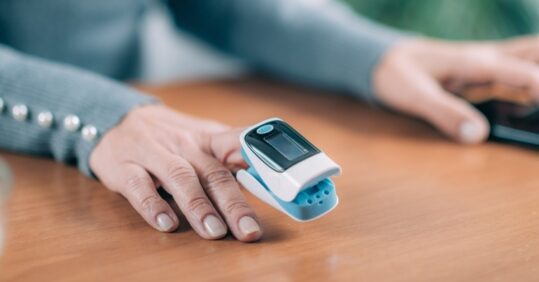Pathways and protocols for NHS England led-Covid Oximetry @home programme

Patients at greatest risk of poor clinical outcomes from Covid-19 are best identified by oxygen levels.1 Last summer NHS England issued guidance on pulse oximetry to measure oxygen levels in patients with confirmed or suspected Covid-19, in order to identify silent hypoxia and to detect early deterioration when monitoring patients remotely in primary and community care.2
In November 2020, NHSE stipulated that all Clinical Commissioning Groups (CCG) should implement the Covid oximetry at home model (Covid Oximetry @home).3 This facilitates the prompt identification of patients needing further treatment, including admission to hospital.
This earlier detection improves mortality rates and reduces the numbers requiring ventilation and to go to an intensive care unit (ICU). Each CCG should have a named person responsible for the service. National support, including the supply of oxygen saturation probes (meeting standard ISO 80601-2-61:2017) is intended for patients in the entry criteria group. The Covid-19 primary care standard operating procedure supports the guidance.4 Running in conjunction with this, the Covid virtual ward model is a secondary care-led initiative to support early and safe discharge from hospital for Covid patients (see box). It has been shown to reduce emergency admissions and builds on Covid Oximetry @home.5
Oximetry @home entry criteria
Patients with suspected Covid-19 should be assessed for alternative diagnoses before being put on the remote monitoring pathway. Current evidence suggests the patient groups that will benefit most are those:
- Diagnosed with Covid-19, either clinically or with a positive test result and
- Showing symptoms and either
- Aged 65 years or older or
- Under 65 and clinically extremely vulnerable (CEV) to Covid-19.
The CEV serves as a guide to eligibility, but clinician discretion may be used and multiple other Covid-19 risk factors can be considered. Many practices have gone beyond the national guidance to include groups such as those aged over 50 years. Other vulnerable groups that could be included are homeless patients,6 and those with learning disabilities (who have a 3.6 times greater mortality risk if they develop Covid-19 compared with the general population).7
Related Article: Quick quiz: Management of COPD
The patient journey
Stage 1 – referral
This model is predominantly instigated in primary care. Referrals may also come via the 111 Covid Clinical Assessment Service (CCAS), and from NHS Test and Trace, A&E and secondary care discharge. Patients presenting directly to general practice should be assessed and not redirected to NHS 111, in order to prevent delay in their care.
Stage 2 – triage
Patients referred to the service require clinical assessment by the GP if this was not done at stage 1, with a face-to-face consultation if appropriate. Shared decision-making is required before entry to the pathway, with a discussion about support for patients or carers. A risk assessment is needed to evaluate the safety of onboarding a patient remotely. A face-to-face route, which may involve carers or relatives, may be safer. Figure 1 outlines the pathway with reference to oxygen saturation levels. Exertion oximetry at triage, if clinically appropriate, can help identify suitability for entry into this monitoring pathway.
Clinician-supervised exertion oximetry (including the 40-step walk and the one-minute sit-to-stand tests) should be done with patients who have a minimum saturation of 93% to detect desaturation and facilitate identification of those at risk of deterioration.2,8 These tests are important in identifying silent hypoxia, but should be attempted with caution. In remote assessments they should only be used where the patient has a minimum resting saturation of 96%.8
Stage 3 – onboarding
Patients should be given a pulse oximeter and supporting information,9,11 including a paper diary, or an app or regular call system. There should be contact details to report oximetry readings and symptoms, and safety netting instructions. This information should be supplied immediately if the patient is seen face to face or within 12 hours if assessed remotely. Different local systems operate for delivery of oximeters to patients’ homes, including the national NHS volunteer responders.9
Related Article: Over one million children living in homes causing asthma and chronic illness
Stage 4 – monitoring
Text/email prompts or check-in calls to the patient should be used as agreed at onboarding. A suggested message and phone script is available on the NHS @home platform.11 Communications with the patient should confirm correct oximeter and diary use, and that oxygen saturations are 95% or above.
Stage 5 – recovery and discharge
Patients who do not show signs of clinical deterioration within 14 days of symptom onset are discharged with safety netting advice, and arrangements made for the return of the oximeter device.11 Patients may be discharged sooner if they have tested negative for Covid-19, or if clinically appropriate. Patients with persistent symptoms at 14 days will require clinical assessment. Once the oximeter is returned, decontamination must be undertaken in accordance with infection control policies for reusable electronic equipment.12
Guidance on decontaminating oximeters
Routine decontamination of reusable non-invasive patient
care equipment
Procedure for decontamination of remote monitoring pack
Related Article: Parents need repeat contact and more time with practice nurses on childhood jabs
The Covid Crisis Rescue Foundation provides an urgent oximeter response service. You can support this service here.
REFERENCES
- https://jamanetwork.com/journals/jama/fullarticle/2765184
- https://www.england.nhs.uk/coronavirus/wp-content/uploads/sites/52/2020/06/C0445-remote-monitoring-in-primary-care-jan-2021-v1.1.pdf
- https://www.england.nhs.uk/coronavirus/wp-content/uploads/sites/52/2020/11/[email protected]
- https://www.england.nhs.uk/coronavirus/wp-content/uploads/sites/52/2020/03/CO800-COVID-19-Primary-Care-SOP-GP-practice_V4.pdf
- https://www.england.nhs.uk/coronavirus/wp-content/uploads/sites/52/2021/01/C1042-sop-discharge-covid-virtual-ward-13-jan-21.pdf [Note: This link is no longer live. See: https://www.england.nhs.uk/coronavirus/wp-content/uploads/sites/52/2021/01/C1517-covid-19-sop-covid-virtual-ward-v2.1.pdf]
- https://www.thelancet.com/journals/lanres/article/PIIS2213-2600(20)30396-9/fulltext
- https://www.gov.uk/government/publications/covid-19-deaths-of-people-with-learning-disabilities.
- http://www.cebm.net/covid-19/what-is-the-efficacy-and-safety-of-rapid-exercise-tests-for-exertional-desaturation-in-
- https://www.england.nhs.uk/coronavirus/wp-content/uploads/sites/52/2020/06/Pulse-Oximeter-Easy-Read-final-online-v4.pdf
- https://nhsvolunteerresponders.org.uk/referral; https://goodsamapp.org/NHSreferrals
- For further guidance and support see the NHS @home Future NHS platform: https://future.nhs.uk/NHSatH/grouphome.
- https://assets.publishing.service.gov.uk/government/uploads/system/uploads/attachment_data/file/877533/Routine_decontamination_of_reusable_noninvasive_equipment.pdf

See how our symptom tool can help you make better sense of patient presentations
Click here to search a symptom




